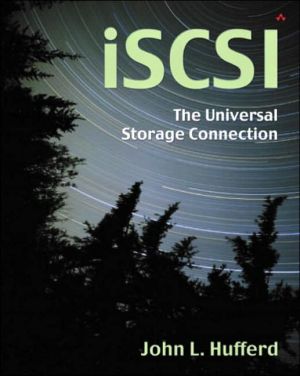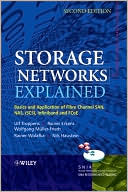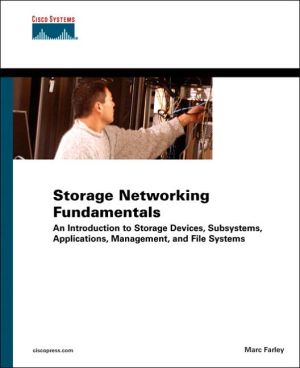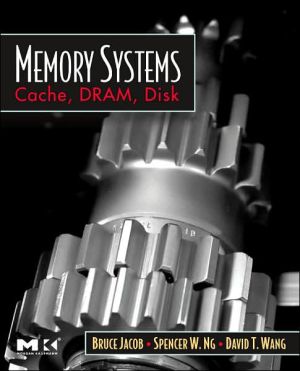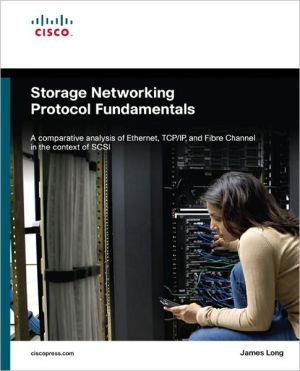iSCSI: The Universal Storage Connection
iSCSI: The Universal Storage Connection is an informative overview and in-depth guide to the emerging iSCSI standard, the technology that enables data storage, access, and management over networks, intranets, and the Internet. The iSCSI protocol reduces the total cost of ownership of shared storage solutions and enables an organization to tie together disparate systems and data, including both server class systems and laptop and desktop systems. Numerous leading technology companies,...
Search in google:
Written for network and data storage professionals, this guide introduces iSCSI and explores its role in the industry. It describes the major elements of the technology and examines the relationship between iSCSI and its predecessors. The book also includes a discussion of developing technologies and the direct memory placement of iSCSI messages. Hufferd is a manager with IBM. Annotation c. Book News, Inc., Portland, OR
This book is a guide to understanding Internet SCSI (iSCSI) and where it fits in the world. It contains discussions of the marketplace where appropriate and of some technology competitors, such as Fibre Channel. However, mostly there will be positioning of the various technologies to emphasize their appropriate strengths. iSCSI is based on such a ubiquitous network technology (TCP/IP) that it seems to play in many different areas that are currently dominated by other technologies. Therefore, one needs to view all iSCSI capabilities and determine its applicability to the area in which the reader is interested.\ Since iSCSI is only a transport, that is, a carrier of the SCSI protocol, there is no involved discussion of SCSI itself. Many parts of the book are general enough that a thorough knowledge of SCSI is not needed. There are, however, more detailed parts of the book where SCSI knowledge would be helpful.\ I wrote this book to provide both the manager and the technician with a useful understanding of the technology. Product marketing and strategy professionals should also find the information useful and meaningful. The technician should view this book as a primer, in which the iSCSI technology is discussed with enough depth that the IETF iSCSI documents should be readily understandable. Those who want to understand and build a product based on iSCSI should find this book to be a must-read, especially if they plan to dive down into the details of the IETF iSCSI drafts/standards documents.\ The book attempts to service divergent readers by ensuring that, when a chapter contains in-depth technical content, the reader will be so advised by a "To the Reader" commentary, which is flagged with the iSmiley face. If appropriate, readers may skip forward to a topic or the Chapter Summary (also marked with the iSmiley face) for the highlights.\ Organization\ The book begins with a general background of the market and an answer to why iSCSI is of interest. A taxonomy of the various markets is given, along with an explanation of how iSCSI fits into them. This is followed by a short history of iSCSI so that the reader can get a sense of what propelled its development.\ Next the book heads into the technology itself, with an overview that includes iSCSI layering. This shows the use of the underpinning TCP/IP technology, the concept of a session, and the structure of the message units. Various other key concepts are introduced here to ensure that the reader knows not only the importance of data integrity to storage technology, but also that new hardware is being introduced specifically to address bandwidth and latency issues. A few pages are spent explaining the iSCSI naming conventions, because of their major significance to the use of the technology.\ Following the discussion of iSCSI naming conventions, the book takes the reader through the login process and the identification and option negotiation process. These processes are key in the establishment of a communication path between the host system and the storage controller. The process of sequencing the commands and data, as well as controlling the flow of commands and data, is reviewed.\ One chapter is dedicated to merging iSCSI concepts with SCSI concepts, by depicting where the various named entities are located. This is perhaps the most tedious chapter, even though not deep in technical content.\ The various forms of task and error management are explained in a very technical discussion. The detail and technical depth build from that point to the end of the book. Finally the reader is taken through the various companion technologies that iSCSI uses to complete its suite of capabilities.\ The main part of the book concludes with an explanation of what hardware vendors are doing to permit direct memory placement of iSCSI messages without additional main processor involvement.\ Of course, there is an overall summary that considers expectations for the future.\ Appendix A contains most of the truly technical details of the iSCSI protocol. The message units are presented in alphabetical order for ease of reference. Appendix B contains a compact listing of the various negotiation keywords and values.\ Appendix C goes into the relationship of iSCSI to the SCSI architecture. It explains the logical model and its consequences. Appendix D contains the details of the key=value field encodings of numbers, characters, and bits.\ Readers may forget from time to time the meanings of various iSCSI and SCSI terms, so a glossary is presented in Appendix E. As a further aid I have included in Appendix F the various acronyms used throughout this book and many of the referenced documents, especially the base IETF iSCSI drafts.\ Finally, Appendix G contains the various reference sources, along with their Web page locators (in most cases). Speaking of references, bracketed citations, such as SAM2, are fully referenced in this appendix.\ In iSCSI, serial numbers are always incremented and compared in what is called a 32-bit serial number arithmetic. This is a way to determine, when serial numbers wrap around, if those numbers are greater or less than other serial numbers.
Credits and DisclaimerPrefaceCh. 1The Background of SCSI1Ch. 2The Value and Position of iSCSI13Ch. 3The History of iSCSI41Ch. 4An Overview of iSCSI49Ch. 5Session Establishment71Ch. 6Text Commands and Keyword Processing93Ch. 7Session Management103Ch. 8Command and Data Ordering and Flow119Ch. 9Structure of iSCSI and Relationship to SCSI139Ch. 10Task Management151Ch. 11Error Handling157Ch. 12Companion Processes171Ch. 13Synchronization and Steering193Ch. 14iSCSI Summary and Conclusions205App. AiSCSI Function PDUs219App. B: Keys and Values297App. C: SCSI Architecture Model305App. D: Numbers, Characters, and Bit Encodings309App. E: Definitions313App. F: Acronyms317App. G: References and Web Pointers323Index329
